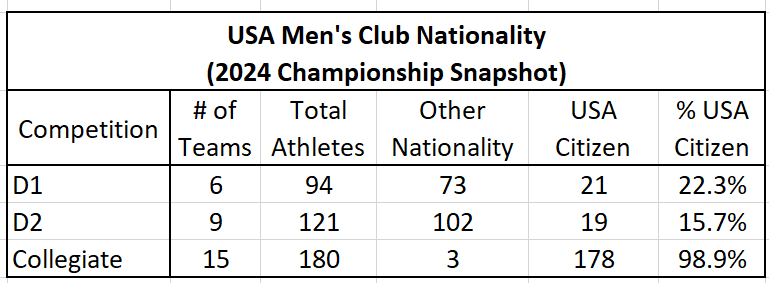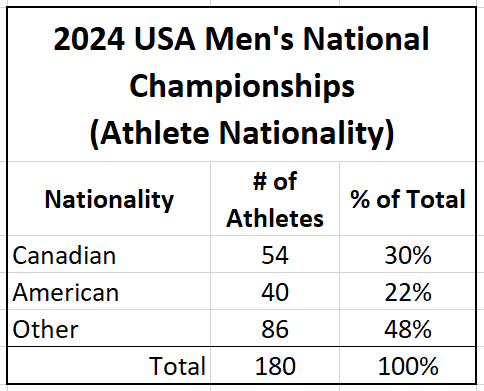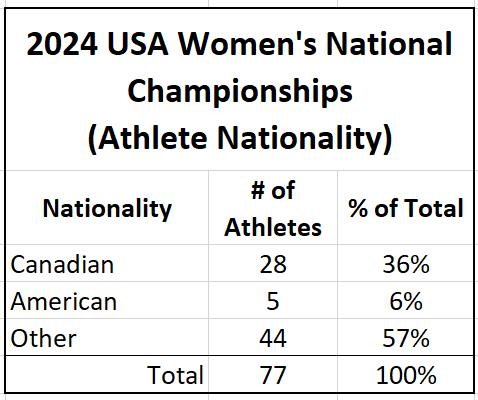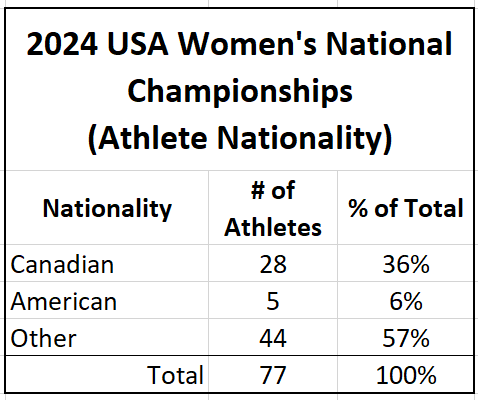The USA Team Handball National Championships took place this past weekend in Spokane, Washington. I didn’t attend, but still have a few thoughts regarding this competition. In part 1, I take a look at the demographics of the participating teams.
Overview
A total of 20 teams participated this past weekend at the U.S. National Handball Championships .There were 6 men’s team in Divsion 1; 9 men’s teams in Division 2 and 5 women’s teams taking part. Thee California Eagles won the Men’s D1 title. The Prairie Selects from Canada won the Men’s D2 title and the NYC Team Handball Club took home the Women’s title. All the results can be accessed here: Link
Methodology
To create a demographics snapshot I reviewed the rosters that were available for viewing online in USA Team Handball’s Sport 80 platform: Link (Note: this link will probably disappear shortly after the tournament is completed).
I then reviewed the names on the rosters, using a mixture of personal knowledge and an “assessment” as to whether the name was likely that of an American citizen. Of course, anyone familiar with what a melting pot the U.S. is, knows that such an assessment is going to have errors. To counteract such errors if a club had 10 “foreign looking” names I figured that at least 2 or 3 of them might be deceptive and factured that into the totals. So, while this data has precise numbers they most certainly aren’t. Still for the purposes of this snapshot look these numbers are probably not too far off.
For the 2024 College National Championships held in April I used an average of 12 athletes/team and feedback from players and coaches as to whether any participating students didn’t have U.S. citizenship. Again, not perfect data, but useful.
Demographics Snapshot
Here’s an overview of the nationality for both the men’s and women’s athletes at this year’s championships:


With two Canadian women’s teams and five Canadian men’s teams participating in Division 2 I also thought it woud be interesting to assess Canadian participation. As suspected, there were likely more Canadians than Americans participating at the U.S. National Championships. This assumes the Canadian teams were mostly Canadians. Not to mention the fact that based on social media posts I think Boston might have had more Canadians than Americans playing for them.


Low American Citizenship Participation
Optically, this data should raise a few eyebrows. The athletes at the U.S. Men’s Handball Championship are only around 20-25% American citizens. The Women’s Championship had only around 5-10%. More Canadians than Americans participating in a U.S. Championship. Really? How can that be?
Well, it’s just the reality of handball in the U.S. And, it’s nothing new. It’s pretty much been this way for the last 20 years or so. I did some similar analysis back in 2019:
- USA Club Programs
- Part 1: Understanding the USA Club Structure and At-Large Men’s Clubs: Link
- Part 2: Collegiate Men’s Clubs: Our Most American Competition with Opportunities for Growth: Link
- Part 3: USA Women At-Large and Collegiate Clubs: Link
- Part 4: Why there are so Few Clubs and Why the Rosters Mostly Consist of Expats: Link
If one looks back at the 2019 data you’ll find similar percentages for the Championships that year, albeit a bit higher in terms of American participating. As both the data for the 2019 and 2024 championships are snapshots one shouldn’t see either year as definitive. And, for sure, this year is a bit quirky with the Championships again being held in the harder to get to location of Spokane, Washington and another entity (the US Handball Union) organizing most of the tournaments this year.
It would be super interesting to see this data tracked year to year, but anecdotally with some authority I’ll just say that the U.S. Open Club Handball Championships could be pretty much described as an expat handball festival with some Americans sprinkled in for good measure. That’s not necessarily a bad thing… or a good thing. But, that is what it is.
For old timers this reality is somewhat hard to stomach. This is because our national championships in the 80s and 90s were essentially the reverse: Mostly American citizens with some expats sprinkled in for good measure.
At this year’s championships I think only San Francisco CalHeat’s 2nd team and, possibly the Wolves (based out of Denver) had teams where the majority of the athletes were American citizens. If you took all the male U.S. citizens (~40) that particpated and put them all together you could probably form a total of 3 teams. And, I don’t even think we could have fielded a single U.S. women’s team. Further, if one wants to separate out naturalized American citizens and Americans that grew up in other countries the numbers would be even worse.
Low American Participation: Does it Matter? Should anything be done about it?
But, do these low American participation rates actually matter? The answer to that question depends on your perspective. Intrinsically, I think everyone, even expats, would really like to see more Americans playing. That said I’ve seen a number of different reactions to include:
- Action is needed to address the problem: A handful of people would like to see regulations to increase American participation. This could include the elimination of foreign clubs participating and limiting the number of foreign athletes on rosters.
- Simply not a problem: Some people get annoyed with the mere thought of “binning” athletes by their nationality “It’s devisive and it just doesn’t matter… we’re here to play handball and we don’t care where anyone is from.”
- Resignation: The old, “It is what is is” mantra applies here. We may not like it, but there’s not a whole lot that can be done about it. I think most people probably fall into this camp.
My Perspective: Staus Quo on Adult Clubs, All in on Collegiate
A part of me would like to see some regulations and incentives that would incentivize U.S. clubs to increase their American citizenship numbers. A combination of “carrots and sticks” with hopefully more carrots than sticks. Right now there is little to no incentive for a club to make such an effort. Organizing and running a club is hard enough as it is. Convincing American citizens to play and then teaching them to play, all while being competitive is next to mission impossible. Most clubs are not likely to really tackle this challenge unless they get some help or are essentially forced to.
But, while USA Team Handball could implement an incentive strategy I’m not so sure it would work. Carrots to incentivize developing American players would probably be received favorably, but there would certainly be resistance to any sort of roster control. And, I don’t think carrots alone would be sufficient enough to do the trick.
Because of this reality, I’m inclined (or perhaps resigned) to maintaining the status quo. Provide our expat teams and even Canadian clubs the opportunity to compete in a National Championships. Competition is good and who knows maybe some old school, primarily American citizen teams will also start to emerge.
Instead, I think efforts to expand the number American citizens playing handball should simply follow the data. All one has to do is look at the percentage of Americans playing college handball which is near 100%. And, the resources and structures that colleges provide to their club sports. And, the multitude of students all living in the same location looking for a club to join. It is a no-brainer as to where the focus should be if one wants to gets more Americans playing the sport: It should go towards expanding and improving the collegiate game.
So, while the low American participation rate at the U.S. National Championships is a concern I would be hesitant to enact new rules to increase the numbers of Americans playing. In part 2 of this series I will take a closer look at the super clubs that often take home the title.
